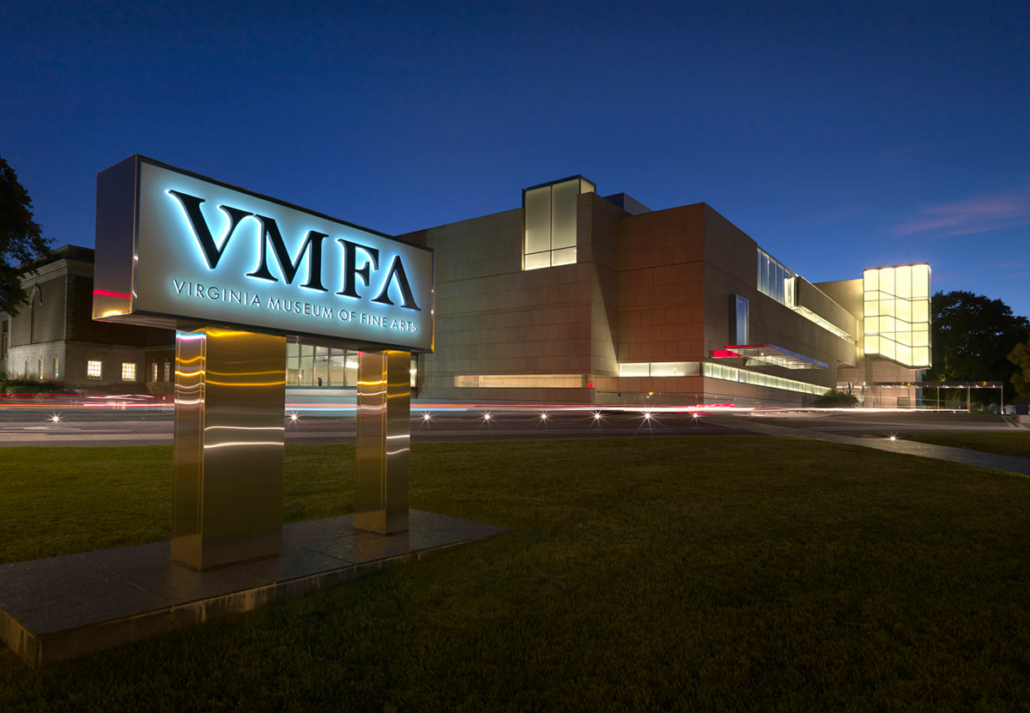
RICHMOND, Va. (AP) – The Virginia Museum of Fine Arts announced a 200,000-square-foot expansion and renovation project that will cost more than $190 million. It is expected to be completed in 2025.
SmithGroup, an international architecture firm with an office in Washington, D.C., has been chosen as the designer of the project.
It is “the largest expansion and renovation project in the history of museum,” said Alex Nyerges, the VMFA’s director and CEO.
This will be the museum’s fifth expansion. The VMFA’s last major expansion was completed in 2010 for the James W. and Frances G. McGlothlin Wing with its connecting Louise B. and J. Harwood Cochrane Atrium, E. Claiborne and Lora Robins Sculpture Garden and 600-car parking garage.
That expansion added 165,000 square feet, providing 50% more gallery space for the museum’s permanent collections, and cost $150 million. It also changed the main entrance to the museum and added the Best Cafe and Amuse restaurant.
The new expansion will add a new 100,000-square-foot, five-story wing for African art, photography and 21st century art off of the existing Mellon and Lewis Wing. The expansion will include an addition of between 11,000 and 12,000 square feet of new exhibition space for major special exhibitions like the Picasso exhibit or The Dirty South exhibit as well as a new special events space with dining facilities that can seat up to 500 guests on the garden-level ground floor.
The expansion will add 200 parking spaces to the museum’s existing 600 parking spaces.
A new 40,000-square-foot stand-alone Collections Center building will be added to the campus to house the museum’s conservation department, as well as registration and art storage.
The plan also calls for 45,000 square feet of renovation in the buildings that had been built in 1936, 1954, and 1970, as well as upgrades to the Leslie Cheek Theater, Evans Court, and the 1936 entrance. The renovations include transforming the museum’s former library into the Raysor Center, a dedicated photography, prints, and drawings study center.
With the addition of the new 100,000-square-foot wing, the museum will be able to seamlessly showcase its collections, Nyerges said.
“For the first time in our history, we’ll be able to show 19th-century French impressionism in one suite of galleries,” he said. “We’ll be able to tell the story of European art much better.”
When the African art is moved into the new wing, the Egyptian collection will move with it.
“That will unite a storyline that’s long been less understood and that we think is an important part of the renovation and expansion,” Nyerges said.
The space for American art will almost double. The new wing will also house 21st-century art, which Nyerges said the museum had already outgrown when it opened the 2010 expansion.
“Contemporary art by its nature is very large and when we opened the McGlothlin Wing, we were only 10 years into the century,” Nyerges said.
With the addition of the new exhibition space, the museum will be able to close the three-month gap between major exhibitions. Some major exhibitions will be able to overlap with the new space and the existing special exhibition space on the lower level.
“We will always have a main exhibition on view. This will boost tourism, attendance and the ability to have an even greater variety of exhibitions than we currently have,” Nyerges said.
Without the 2010 expansion, none of this expansion and renovation would be possible, he said.
The 2010 expansion and creation of the McGlothlin Wing created an “avalanche of gifts and expansion to the collection,” Nyerges said. “It proved the saying, ‘Build it and they will give.'”
After 2010, the museum added the James W. and Frances Gibson McGlothlin Collection of American Art, the Ludwig and Rosy Fischer Collection of German-Expressionist art, the Pamela K. and William A. Royall Jr. Collection of 21st-century art, the Frank Raysor Collection of prints on paper, and the Louis H. Draper Collection and Archive, to name a few.
The museum has also been actively building its African American art to become one of the three best collections of African American art anywhere. Over the past 10 years, 40% of the museum’s purchases have been African American and African art.
Funds for the project were approved in the 2020 General Assembly session. Approximately $112 million for this project was approved as part of a capital pool from bond proceeds of the Virginia Public Building Authority. The VMFA is pursuing contributions from private and corporate donors for the remainder of the expansion costs.
SmithGroup has designed museums and projects for the United States Holocaust Memorial Museum Collections and Conservation Center in Maryland and the Detroit Institute of Arts in Michigan, as well as the National Museum of the American Indian and the National Museum of African American History and Culture in Washington.
The VMFA received more than 30 proposals from architects all over the world before choosing SmithGroup.
Nyerges said SmithGroup had several advantages, including its focus on museums and cultural venues and its Virginia connection.
Jame Anderson, the group’s director and principal in charge, grew up in Prince Edward County and was first exposed to art with a visit from the VMFA’s Artmobile. Several key architects in the core group also grew up in Richmond.
SmithGroup will begin its design exploration and processes, which is expected to take 24 months and be completed in June 2023. After the designs are approved and construction contractors selected, work will begin and is expected to take two years, with completion slated for 2025.
By COLLEEN CURRAN, Richmond Times-Dispatch
Copyright 2021 Associated Press. All rights reserved. This information may not be published, broadcast, rewritten, or redistributed.


